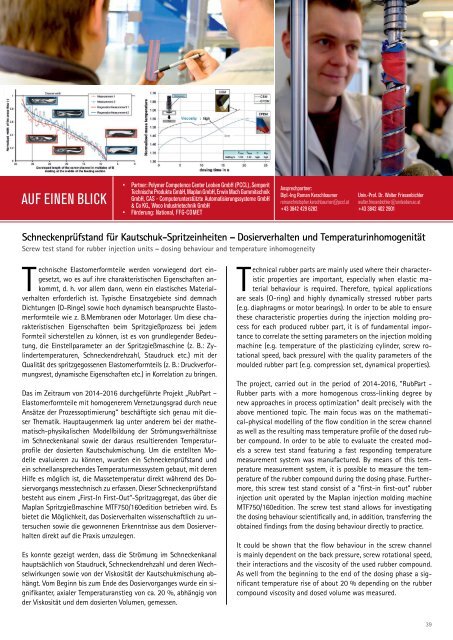Kunststofftechnik Leoben - Zweijahresbericht 2015 - 2016
Erfolgreiche ePaper selbst erstellen
Machen Sie aus Ihren PDF Publikationen ein blätterbares Flipbook mit unserer einzigartigen Google optimierten e-Paper Software.
AUF EINEN BLICK<br />
• Partner: Polymer Competence Center <strong>Leoben</strong> GmbH (PCCL), Semperit<br />
Technische Produkte GmbH, Maplan GmbH, Erwin Mach Gummitechnik<br />
GmbH, CAS - Computerunterstützte Automatisierungssysteme GmbH<br />
& Co KG., Woco Industrietechnik GmbH<br />
• Förderung: National, FFG-COMET<br />
Ansprechpartner:<br />
Dipl.-Ing Roman Kerschbaumer<br />
romanchristopher.kerschbaumer@pccl.at<br />
+43 3842 429 6282<br />
Univ.-Prof. Dr. Walter Friesenbichler<br />
walter.friesenbichler@unileoben.ac.at<br />
+43 3842 402 2901<br />
Schneckenprüfstand für Kautschuk-Spritzeinheiten – Dosierverhalten und Temperaturinhomogenität<br />
Screw test stand for rubber injection units – dosing behaviour and temperature inhomogeneity<br />
Technische Elastomerformteile werden vorwiegend dort eingesetzt,<br />
wo es auf ihre charakteristischen Eigenschaften ankommt,<br />
d. h. vor allem dann, wenn ein elastisches Materialverhalten<br />
erforderlich ist. Typische Einsatzgebiete sind demnach<br />
Dichtungen (O-Ringe) sowie hoch dynamisch beanspruchte Elastomerformteile<br />
wie z. B.Membranen oder Motorlager. Um diese charakteristischen<br />
Eigenschaften beim Spritzgießprozess bei jedem<br />
Formteil sicherstellen zu können, ist es von grundlegender Bedeutung,<br />
die Einstellparameter an der Spritzgießmaschine (z. B.: Zylindertemperaturen,<br />
Schneckendrehzahl, Staudruck etc.) mit der<br />
Qualität des spritzgegossenen Elastomerformteils (z. B.: Druckverformungsrest,<br />
dynamische Eigenschaften etc.) in Korrelation zu bringen.<br />
Das im Zeitraum von 2014-<strong>2016</strong> durchgeführte Projekt „RubPart –<br />
Elastomerformteile mit homogenerem Vernetzungsgrad durch neue<br />
Ansätze der Prozessoptimierung“ beschäftigte sich genau mit dieser<br />
Thematik. Hauptaugenmerk lag unter anderem bei der mathematisch-physikalischen<br />
Modellbildung der Strömungsverhältnisse<br />
im Schneckenkanal sowie der daraus resultierenden Temperaturprofile<br />
der dosierten Kautschukmischung. Um die erstellten Modelle<br />
evaluieren zu können, wurden ein Schneckenprüfstand und<br />
ein schnellansprechendes Temperaturmesssystem gebaut, mit deren<br />
Hilfe es möglich ist, die Massetemperatur direkt während des Dosiervorgangs<br />
messtechnisch zu erfassen. Dieser Schneckenprüfstand<br />
besteht aus einem „First-In First-Out“-Spritzaggregat, das über die<br />
Maplan Spritzgießmaschine MTF750/160edition betrieben wird. Es<br />
bietet die Möglichkeit, das Dosierverhalten wissenschaftlich zu untersuchen<br />
sowie die gewonnenen Erkenntnisse aus dem Dosierverhalten<br />
direkt auf die Praxis umzulegen.<br />
Es konnte gezeigt werden, dass die Strömung im Schneckenkanal<br />
hauptsächlich von Staudruck, Schneckendrehzahl und deren Wechselwirkungen<br />
sowie von der Viskosität der Kautschukmischung abhängt.<br />
Vom Beginn bis zum Ende des Dosiervorganges wurde ein signifikanter,<br />
axialer Temperaturanstieg von ca. 20 %, abhängig von<br />
der Viskosität und dem dosierten Volumen, gemessen.<br />
Technical rubber parts are mainly used where their characteristic<br />
properties are important, especially when elastic material<br />
behaviour is required. Therefore, typical applications<br />
are seals (O-ring) and highly dynamically stressed rubber parts<br />
(e.g. diaphragms or motor bearings). In order to be able to ensure<br />
these characteristic properties during the injection molding process<br />
for each produced rubber part, it is of fundamental importance<br />
to correlate the setting parameters on the injection molding<br />
machine (e.g. temperature of the plasticizing cylinder, screw rotational<br />
speed, back pressure) with the quality parameters of the<br />
moulded rubber part (e.g. compression set, dynamical properties).<br />
The project, carried out in the period of 2014-<strong>2016</strong>, “RubPart -<br />
Rubber parts with a more homogenous cross-linking degree by<br />
new approaches in process optimization” dealt precisely with the<br />
above mentioned topic. The main focus was on the mathematical-physical<br />
modelling of the flow condition in the screw channel<br />
as well as the resulting mass temperature profile of the dosed rubber<br />
compound. In order to be able to evaluate the created models<br />
a screw test stand featuring a fast responding temperature<br />
measurement system was manufactured. By means of this temperature<br />
measurement system, it is possible to measure the temperature<br />
of the rubber compound during the dosing phase. Furthermore,<br />
this screw test stand consist of a “first-in first-out” rubber<br />
injection unit operated by the Maplan injection molding machine<br />
MTF750/160edition. The screw test stand allows for investigating<br />
the dosing behaviour scientifically and, in addition, transferring the<br />
obtained findings from the dosing behaviour directly to practice.<br />
It could be shown that the flow behaviour in the screw channel<br />
is mainly dependent on the back pressure, screw rotational speed,<br />
their interactions and the viscosity of the used rubber compound.<br />
As well from the beginning to the end of the dosing phase a significant<br />
temperature rise of about 20 % depending on the rubber<br />
compound viscosity and dosed volume was measured.<br />
39


